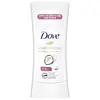Dove Whole Body Deodorant Anti-Friction Stick Versus Dove Advanced Care Antiperspirant Deodorant Stick
What's inside
What's inside
 Key Ingredients
Key Ingredients

 Benefits
Benefits

 Concerns
Concerns

 Ingredients Side-by-side
Ingredients Side-by-side

Cocos Nucifera Oil
MaskingCaprylic/Capric Triglyceride
MaskingMaranta Arundinacea Root Powder
Skin ConditioningHelianthus Annuus Seed Wax
Skin ConditioningOryza Sativa Bran Wax
Skin ConditioningJojoba Esters
EmollientButyrospermum Parkii Butter
Skin ConditioningParfum
MaskingSilica
AbrasiveZinc Neodecanoate
Isopropyl Myristate
EmollientNiacinamide
SmoothingTocopheryl Acetate
AntioxidantAllantoin
Skin ConditioningBisabolol
MaskingZingiber Officinale Root Extract
MaskingBenzyl Alcohol
PerfumingCocos Nucifera Oil, Caprylic/Capric Triglyceride, Maranta Arundinacea Root Powder, Helianthus Annuus Seed Wax, Oryza Sativa Bran Wax, Jojoba Esters, Butyrospermum Parkii Butter, Parfum, Silica, Zinc Neodecanoate, Isopropyl Myristate, Niacinamide, Tocopheryl Acetate, Allantoin, Bisabolol, Zingiber Officinale Root Extract, Benzyl Alcohol
Ingredients Explained
These ingredients are found in both products.
Ingredients higher up in an ingredient list are typically present in a larger amount.
Parfum is a catch-all term for an ingredient or more that is used to give a scent to products.
Also called "fragrance", this ingredient can be a blend of hundreds of chemicals or plant oils. This means every product with "fragrance" or "parfum" in the ingredients list is a different mixture.
For instance, Habanolide is a proprietary trade name for a specific aroma chemical. When used as a fragrance ingredient in cosmetics, most aroma chemicals fall under the broad labeling category of “FRAGRANCE” or “PARFUM” according to EU and US regulations.
The term 'parfum' or 'fragrance' is not regulated in many countries. In many cases, it is up to the brand to define this term.
For instance, many brands choose to label themselves as "fragrance-free" because they are not using synthetic fragrances. However, their products may still contain ingredients such as essential oils that are considered a fragrance by INCI standards.
One example is Calendula flower extract. Calendula is an essential oil that still imparts a scent or 'fragrance'.
Depending on the blend, the ingredients in the mixture can cause allergies and sensitivities on the skin. Some ingredients that are known EU allergens include linalool and citronellol.
Parfum can also be used to mask or cover an unpleasant scent.
The bottom line is: not all fragrances/parfum/ingredients are created equally. If you are worried about fragrances, we recommend taking a closer look at an ingredient. And of course, we always recommend speaking with a professional.
Learn more about ParfumSilica, also known as silicon dioxide, is a naturally occurring mineral. It is used as a fine, spherical, and porous powder in cosmetics.
Though it has exfoliant properties, the function of silica varies depending on the product.
The unique structure of silica enhances the spreadability and adds smoothness, making it a great texture enhancer.
It is also used as an active carrier, emulsifier, and mattifier due to its ability to absorb excess oil.
In some products, tiny microneedles called spicules are made from silica or hydrolyzed sponge. When you rub them in, they lightly polish away dead skin layers and enhance the penetration of active ingredients.
Learn more about Silica